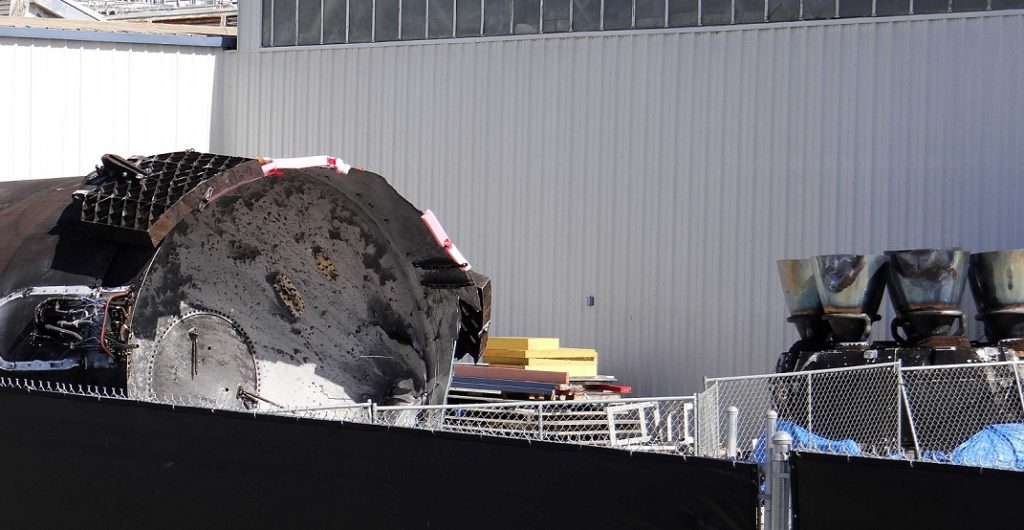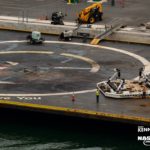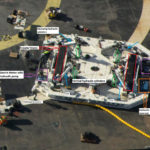News
SpaceX’s mystery “Optimus Prime” drone ship robot spotted testing ahead of BulgariaSat-1 mission
Just a little over three months ago, in mid March, fans of SpaceX caught their first full glimpses of a mysterious robot aboard the drone ship Of Course I Still Love You (OCISLY) while it was docked in Port Canaveral, Florida.
Rapidly deemed “Roomba” and later heard to be internally nicknamed “Optimus Prime”, it was approximately 50 feet (15 meters) across at its widest point and appeared to be extremely heavy due to the way it was handled on the side of the docks, as well as the presence of tracks rather than wheels. The SpaceX community quickly came to the conclusion that it was some sort of robotic tool for remotely securing Falcon 9 first stages following landings aboard SpaceX’s drone ship fleet, as first stages had a tendency to rather precariously slide about drone ships in high seas.
- Optimus Prime roving around OCISLY on June 13th. (Brady Kenniston/NASAspaceflight.com)
- Optimus Prime captured by helicopter while conducting tests in March earlier this year. (Source: Reddit /u/riddlerthc)
This speculation was proven correct during a press conference following the successful launch of SES-10 and SpaceX’s first successful reuse; the Roomba/Optimus Prime was indeed a measure to more rapidly and safely secure first stages after landing aboard drone ships. The primary reason for this robot existing is to better ensure the safety of those working aboard active drone ships. Removing the requirement for people to be aboard a barge with an unsecured 50,000 kilogram rocket that has a tendency to explode violently after falling over.

The hallowed remains of the Falcon 9 that successfully launched Jason-3 but was somewhat less successfully recovered. (NASAspaceflight)
It is currently unclear whether the robot is intended to be a precaution only used in high seas or a tool to be used for every autonomous spaceport drone ship recovery. But the fact that it was seen conducting tests aboard OCISLY just a day before SpaceX’s static fire test for the upcoming launch of BulgariaSat-1 indicates that the upcoming launch may be the robot’s first truly operational test. It is also possible that SpaceX may simply choose to recover the stage and bring it back to port before conducting tests with the robot and an actual Falcon 9 S1 aboard OCISLY, with this latter option forcing less reliance upon a currently unproven (but nevertheless rather simple) technology.
Aside from the morally prescient goal of removing safety hazards for the Falcon 9 recovery crew, the ability to remotely secure Falcon 9 first stages will also avoid the time consuming practice of welding the landing legs and hydraulic jacks to the deck of the barge. This will likely remove hours of cautious procedures designed to protect those working aboard the barge once a stage has landed. As previously discussed on Teslarati, the possibility of weekly launches occurring from Cape Canaveral later this winter or sometime in 2018 gives SpaceX significant motivation to increase the availability of OCISLY, its only East coast-based drone ship.

A Falcon 9 S1 secured the old-fashioned way with leg shoes welded to the deck and hydraulic lifts to keep weight off the legs. (NASAspaceflight)
While the several days typically required to sail several hundred miles to the barges’ recovery destinations are not about to change, the ability to remotely secure recovered stages will both drastically improve the safety of the recovery crew and allow OCISLY to spend less time on station in the Atlantic, and thus more time back in port to offload its Falcon 9 payload and prepare for the next recovery.
For SpaceX’s goal of rapid reusability, every day and even every hour that can be removed from the process of launching, recovering, and relaunching is time that could theoretically be spent launching the payloads of paying customers, or launching SpaceX’s own payloads of revenue-producing broadband satellites and data-producing Red Dragons. As the saying goes, time is money.

News
Tesla (TSLA) receives “Buy” rating and $551 PT from Canaccord Genuity
He also maintained a “Buy” rating for TSLA stock over the company’s improving long-term outlook, which is driven by autonomy and robotics.

Canaccord Genuity analyst George Gianarikas raised his Tesla (NASDAQ:TSLA) price target from $482 to $551. He also maintained a “Buy” rating for TSLA stock over the company’s improving long-term outlook, which is driven by autonomy and robotics.
The analyst’s updated note
Gianarikas lowered his 4Q25 delivery estimates but pointed to several positive factors in the Tesla story. He noted that EV adoption in emerging markets is gaining pace, and progress in FSD and the Robotaxi rollout in 2026 represent major upside drivers. Further progress in the Optimus program next year could also add more momentum for the electric vehicle maker.
“Overall, yes, 4Q25 delivery expectations are being revised lower. However, the reset in the US EV market is laying the groundwork for a more durable and attractive long-term demand environment.
“At the same time, EV penetration in emerging markets is accelerating, reinforcing Tesla’s potential multi‑year growth runway beyond the US. Global progress in FSD and the anticipated rollout of a larger robotaxi fleet in 2026 are increasingly important components of the Tesla equity story and could provide sentiment tailwinds,” the analyst wrote.
Tesla’s busy 2026
The upcoming year would be a busy one for Tesla, considering the company’s plans and targets. The autonomous two-seat Cybercab has been confirmed to start production sometime in Q2 2026, as per Elon Musk during the 2025 Annual Shareholder Meeting.
Apart from this, Tesla is also expected to unveil the next-generation Roadster on April 1, 2026. Tesla is also expected to start high-volume production of the Tesla Semi in Nevada next year.
Apart from vehicle launches, Tesla has expressed its intentions to significantly ramp the rollout of FSD to several regions worldwide, such as Europe. Plans are also underway to launch more Robotaxi networks in several more key areas across the United States.
News
Waymo sues Santa Monica over order to halt overnight charging sessions
In its complaint, Waymo argued that its self-driving cars’ operations do not constitute a public nuisance, and compliance with the city’s order would cause the company irreparable harm.

Waymo has filed a lawsuit against the City of Santa Monica in Los Angeles County Superior Court, seeking to block an order that requires the company to cease overnight charging at two facilities.
In its complaint, Waymo argued that its self-driving cars’ operations do not constitute a public nuisance, and compliance with the city’s order would cause the company irreparable harm.
Nuisance claims
As noted in a report from the Los Angeles Times, Waymo’s two charging sites at Euclid Street and Broadway have operated for about a year, supporting the company’s growing fleet with round-the-clock activity. Unfortunately, this has also resulted in residents in the area reportedly being unable to sleep due to incessant beeping from self-driving taxis that are moving in and out of the charging stations around the clock.
Frustrated residents have protested against the Waymos by blocking the vehicles’ paths, placing cones, and “stacking” cars to create backups. This has also resulted in multiple calls to the police.
Last month, the city issued an order to Waymo and its charging partner, Voltera, to cease overnight operations at the charging locations, stating that the self-driving vehicles’ activities at night were a public nuisance. A December 15 meeting yielded no agreement on mitigations like software rerouting. Waymo proposed changes, but the city reportedly insisted that nothing would satisfy the irate residents.
“We are disappointed that the City has chosen an adversarial path over a collaborative one. The City’s position has been to insist that no actions taken or proposed by Waymo would satisfy the complaining neighbors and therefore must be deemed insufficient,” a Waymo spokesperson stated.
Waymo pushes back
In its legal complaint, Waymo stated that its “activities at the Broadway Facilities do not constitute a public nuisance.” The company also noted that it “faces imminent and irreparable harm to its operations, employees, and customers” from the city’s order. The suit also stated that the city was fully aware that the Voltera charging sites would be operating around the clock to support Waymo’s self-driving taxis.
The company highlighted over one million trips in Santa Monica since launch, with more than 50,000 rides starting or ending there in November alone. Waymo also criticized the city for adopting a contentious strategy against businesses.
“The City of Santa Monica’s recent actions are inconsistent with its stated goal of attracting investment. At a time when the City faces a serious fiscal crisis, officials are choosing to obstruct properly permitted investment rather than fostering a ‘ready for business’ environment,” Waymo stated.
News
Tesla FSD v14.2.2 is getting rave reviews from drivers
So far, early testers have reported buttery-smooth drives with confident performance, even at night or on twisty roads.

Tesla Full Self-Driving (Supervised) v14.2.2 is receiving positive reviews from owners, with several drivers praising the build’s lack of hesitation during lane changes and its smoother decision-making, among others.
The update, which started rolling out on Monday, also adds features like dynamic arrival pin adjustment. So far, early testers have reported buttery-smooth drives with confident performance, even at night or on twisty roads.
Owners highlight major improvements
Longtime Tesla owner and FSD user @BLKMDL3 shared a detailed 10-hour impression of FSD v14.2.2, noting that the system exhibited “zero lane change hesitation” and “extremely refined” lane choices. He praised Mad Max mode’s performance, stellar parking in locations including ticket dispensers, and impressive canyon runs even in dark conditions.
Fellow FSD user Dan Burkland reported an hour of FSD v14.2.2’s nighttime driving with “zero hesitations” and “buttery smooth” confidence reminiscent of Robotaxi rides in areas such as Austin, Texas. Veteran FSD user Whole Mars Catalog also demonstrated voice navigation via Grok, while Tesla owner Devin Olsen completed a nearly two-hour drive with FSD v14.2.2 in heavy traffic and rain with strong performance.
Closer to unsupervised
FSD has been receiving rave reviews, even from Tesla’s competitors. Xpeng CEO He Xiaopeng, for one, offered fresh praise for FSD v14.2 after visiting Silicon Valley. Following extended test drives of Tesla vehicles running the latest FSD software, He stated that the system has made major strides, reinforcing his view that Tesla’s approach to autonomy is indeed the proper path towards autonomy.
According to He, Tesla’s FSD has evolved from a smooth Level 2 advanced driver assistance system into what he described as a “near-Level 4” experience in terms of capabilities. While acknowledging that areas of improvement are still present, the Xpeng CEO stated that FSD’s current iteration significantly surpasses last year’s capabilities. He also reiterated his belief that Tesla’s strategy of using the same autonomous software and hardware architecture across private vehicles and robotaxis is the right long-term approach, as it would allow users to bypass intermediate autonomy stages and move closer to Level 4 functionality.










